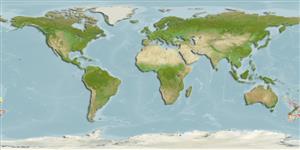Pycnogonida |
Pantopoda |
Callipallenidae
Environment: milieu / climate zone / djupintervall / distribution range
Ekologi
; djupintervall 540 - 750 m (Ref. 9). Temperate
Southwest Pacific to Sub Antarctic waters.
Length at first maturity / Size / Weight / Age
Könsmognad: Lm ? range ? - ? cm Max length : 11.0 cm LS hane/ej könsbestämd; (Ref. 9); 12.2 cm LS (female)
Trunk fully segmented; segments and neck tapering anteriorly. Lateral processes 1.5 times their diameters; all glabrous. Ocular tubercle at extreme anterior of neck; eyes moderately large, darkly pigmented. Oviger implants touching and below first lateral processes. Proboscis is a cylinder, swollen distally and armed with fringe of short setae around mouth. Abdomen moderately short, glabrous. Chelifore scapes almost as long as proboscis; both with hint of median suture, armed distally with fringe of short setae. Chelae with ovoid palms bearing inner field of short setae. Fingers short, of equal length; movable finger with small setose pad at base. Palp buds very large, bulging laterally for most of neck length. Oviger long; second segment long; third segment about 0.6 length of second, both with distal field of tiny setae; fifth longest, about 1.2 longer than fourth. Strigilis seventh and eighth segments with groups of setae longer than segment diameters; other segments with many short setae. Legs moderately long; femora slightly curved; long cement-gland tube about 1.1 times diameter of segment. Second tibiae the longest segments. Tarsus very short, with one broad sole spine. Propodus moderately long, slightly curved with five short broad heel spines and 9 - 10 very short sole spines. Claw short, less than half propodal length; auxiliary claws about 0.7 main claw length. Female slightly larger; abdomen a little longer and upcurved. Propodus with four heel spines and greater number of small sole spines. Ovigers missing.
Life cycle and mating behavior
Könsmognad | Reproduktion | Lek | Eggs | Fecundity | Larvae
Members of the class Pycnogonida are gonochoric and sexually dimorphic. During copulation, male usually suspends itself beneath the female. Fertilization occurs as the eggs leave the female's ovigers. Males brood the egg masses until they hatch. Life cycle: Eggs hatch into protonymphon larva then to adults.
Child, C.A. 1998 The marine fauna of New Zealand: Pycnogonida (sea spiders). NIWA Biodiversity Memoire 109. National Institute of Water and Atmospheric Research (NIWA). Washington, D.C. 20530, USA. 71 p. + Figure 2A-G, 3A-F, 4, 5. (Ref. 9)
IUCN Red List Status
(Ref. 130435: Version 2025-1)
CITES status (Ref. 108899)
Not Evaluated
Not Evaluated
Threat to humans
Harmless
Human uses
| FishSource |
Verktyg
Ytterligare information
Trophic EcologyFood items (preys)
Födosammansättning
Födointag
Predatorer
Population dynamicsTillväxt
Max. ages / sizes
Length-weight rel.
Length-length rel.
Length-frequencies
Mass conversion
Abundans
PhysiologySyreförbrukning
Human RelatedStamps, coins, misc.
Internet-källor
Estimates based on models
Preferred temperature
(Ref.
115969): 5.4 - 6.4, mean 6.2 (based on 10 cells).
Fishing Vulnerability
Low vulnerability (10 of 100).
Price category
Unknown.
